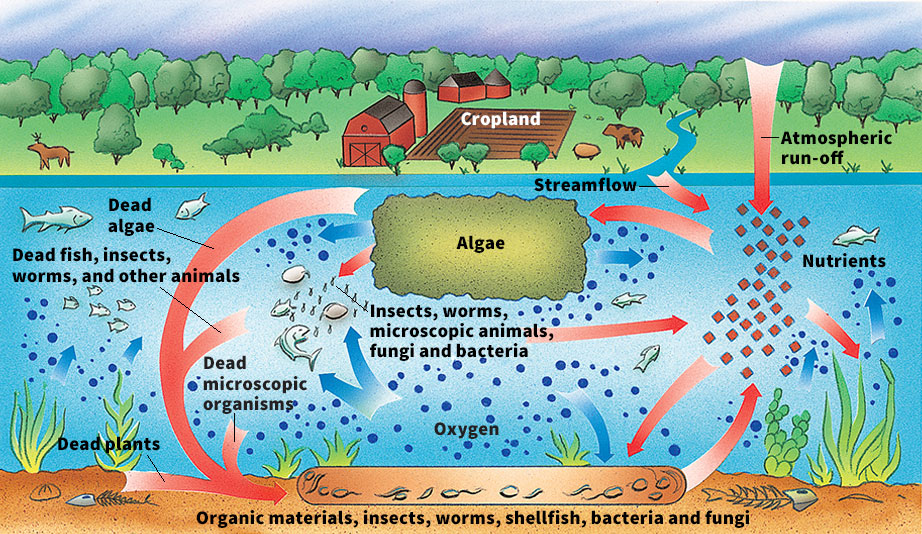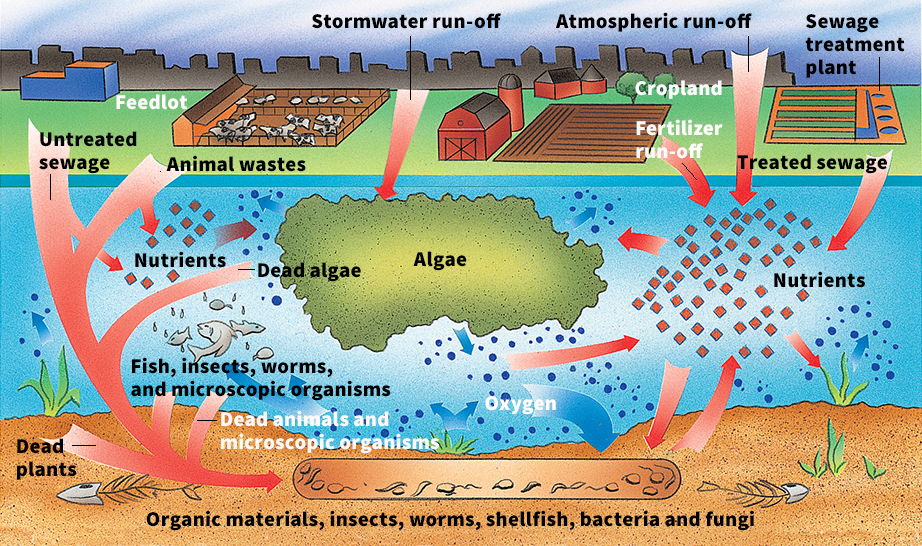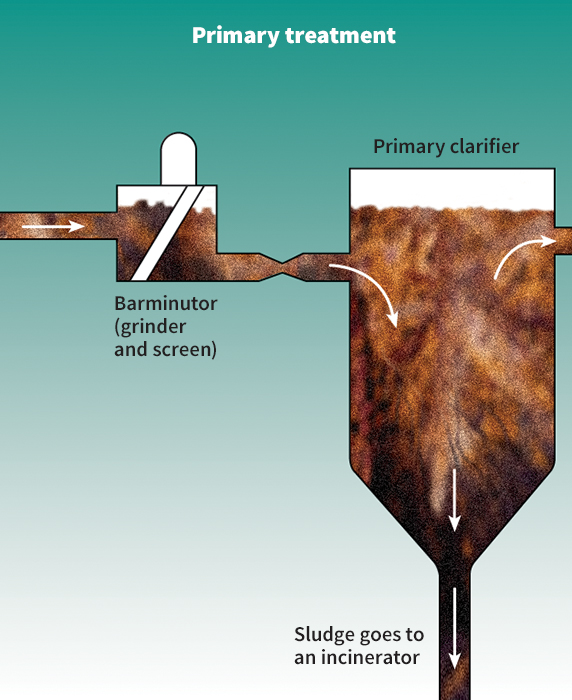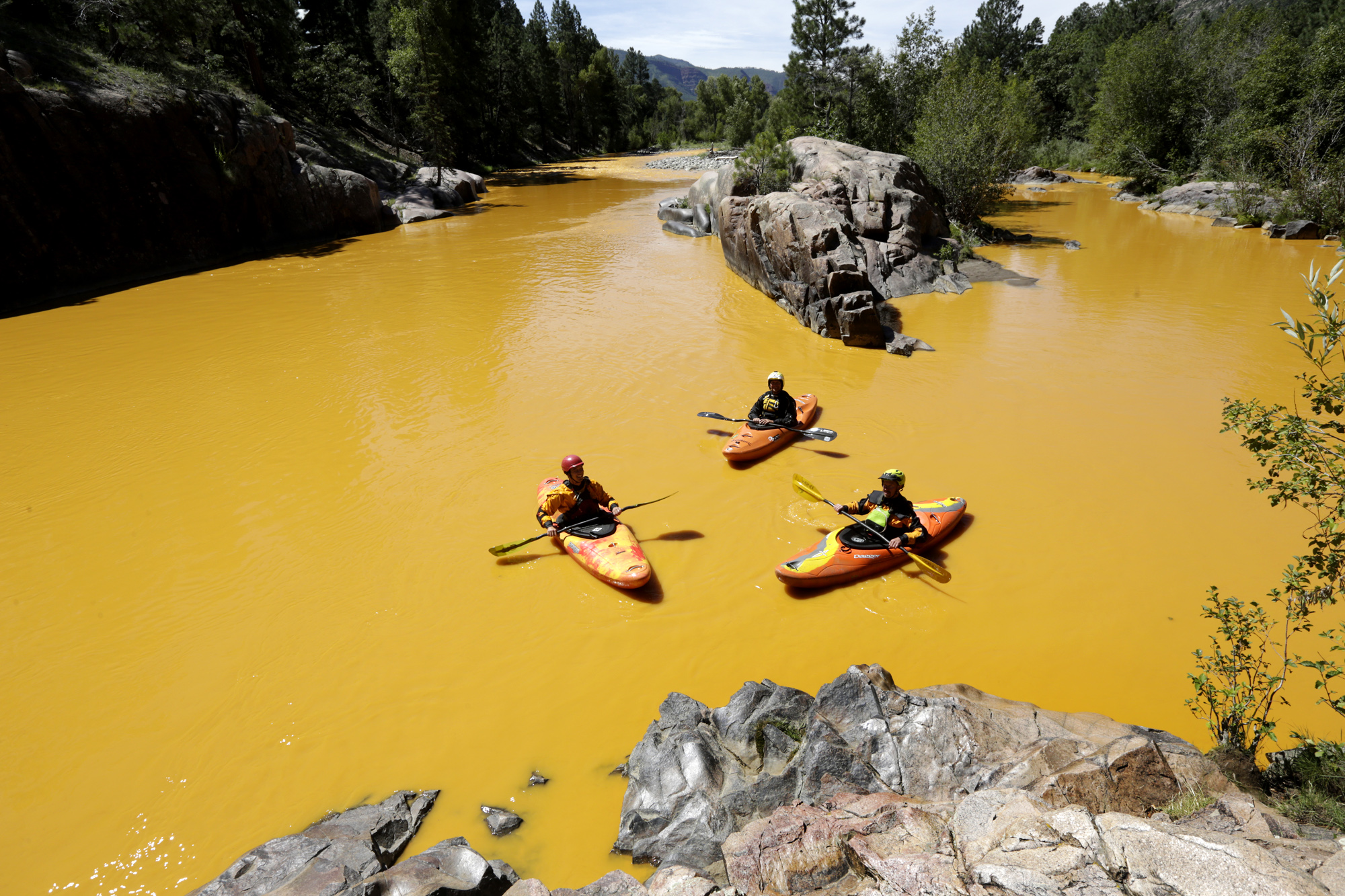Water pollution is adding to a body of water any substance that might degrade its quality. Water pollution remains among the world’s most serious environmental problems. Water pollution can occur in rain; in rivers, lakes, and oceans; and in the water held beneath the ground, called ground water.
Polluted water may appear clean or dirty, but it contains bacteria, viruses, chemicals, or other materials that can cause illness or death in people and other living things. These impurities must be removed before water can be used safely for drinking, cooking, washing, or laundering. Some industries must clean polluted water before using it in manufacturing processes.
Sources
Water pollution comes from a variety of sources. The sources are broadly grouped into two types: point sources and nonpoint sources.
Point sources
are direct, easily identified sources of pollution. In such a source, the pollution occurs at a single point, such as a factory drain or sewage outlet.
Industrial wastes.
Factories and other industrial facilities sometimes discharge pollutants, which may include known hazardous chemicals, directly into nearby bodies of water. In addition, chemicals released into the air frequently find their way into water through rain and other precipitation events. For example, the burning of coal, oil, and other fossil fuels by power plants and factories and in internal combustion engines releases sulfur and nitrogen oxides into the air. These pollutants can dissolve in water droplets suspended in the air, forming acid rain that can enter streams and lakes.
The toxic metal mercury also ranks as a widespread water pollutant. Most mercury water pollution comes from the airborne emissions of coal-fired power plants, trash incinerators, and iron-processing plants. See Mercury (Mercury in the environment).
Some industries pollute water without releasing toxic chemicals. They discharge large quantities of hot water into rivers and lakes, harming living things in an effect called thermal pollution.
Sewage
is water that contains waste matter produced by human beings. Most sewage in developed countries goes into sewerage systems. These systems carry sewage to treatment plants, which may remove solids and such dissolved substances as the nutrients nitrogen and phosphorus. Today, many people, even in developed countries, live in areas without sewers. Some households use underground septic tank systems to store and treat sewage. Others, especially in less developed areas, do not have treatment systems. They release untreated sewage directly into rivers, lakes, and coastal waters.
Nonpoint sources
of water pollution are those that do not come from easily identifiable sources. The most common form of nonpoint-source water pollution is runoff from large areas of land. Water runoff begins with rain, melting ice and snow, and other precipitation events. In natural environments, this water soaks into the ground or collects and evaporates on the surface. In environments modified by people, however, runoff often flows across concrete and asphalt to storm-water drains. As it flows, it picks up litter, such as plastic bags and bottles, and various synthetic chemicals, such as fertilizer, insecticide, salt, motor oil, and grease. Unlike sewage, this water does not go through a treatment process. Instead, it is simply discharged directly into nearby bodies of water, along with any pollutants it picked up along the way. Major sources of nonpoint pollution include construction sites, farmland, golf courses, and roads.
Effects
Water pollution poses a serious public health problem. It also damages the environment, disrupts natural processes, and interferes with the use of natural resources.
Human illness.
Water polluted with human and animal wastes can spread many diseases, including typhoid fever, cholera, and dysentery. Many communities disinfect their water supplies with chlorine or other chemicals to kill disease-causing germs. However, disinfection does not remove harmful chemicals, such as polychlorinated biphenyls (PCB’s) and chloroform, or harmful metals, such as arsenic, lead, and mercury. The careless release of such toxic wastes, primarily into waste dumps, can lead to the contamination of ground water supplies. Scientists have found synthetic chemicals such as PCB’s, chloroform, and pesticides in some public drinking water. Some experts think that drinking even small amounts of these substances over many years may have harmful effects.
Disruption of natural processes.
Water pollution can disrupt natural processes in water that turn wastes into useful or harmless substances. This disruption harms living things primarily by lowering the amount of oxygen dissolved in the water.


Eutrophication.
Aerobic (oxygen-using) bacteria break down organic wastes into simpler substances through a natural process called mineralization. Some of the minerals produced, such as phosphates and nitrates, serve as nutrients for plants. Normal quantities of nutrients help support a balance of life in the water. However, contamination by sewage or fertilizers can add nutrients. When there are too many nutrients, a body of water may suffer from a process called eutrophication.
In eutrophication, excess nutrients cause an unnatural growth in the numbers of plants, plantlike organisms called algae, fish and other animals, and bacteria. As the algae grow, they block the light needed by the plants to produce oxygen, causing the plants to die and decay. Because the decay process requires oxygen, the additional decay uses up more of the oxygen in the water. Less oxygen remains available for living things. Some types of game fish—such as salmon, trout, and whitefish—cannot live in water with reduced oxygen. Fish that need less oxygen, such as carp and catfish, will replace them. If all the oxygen in a body of water is used up, most forms of life in the water will die.
Effects of plastic pollution.
Since the end of World War II (1939-1945), the production and use of plastics has increased dramatically. As the use of plastic has increased, so has its presence in the environment. Plastic has become one of the main water pollutants throughout the world, largely as a result of plastic litter carried in runoff.
Most plastics do not biodegrade (break down over time through organic processes). They simply break into smaller and smaller pieces. Birds, fish, and other aquatic (water-dwelling) species swallow these pieces, possibly mistaking them for food. Once consumed, the plastic pieces collect in an animal’s gastrointestinal tract, interfering with its ability to eat and drink and thus leading to starvation, dehydration, and possibly death. Furthermore, plastic particles can absorb toxic chemicals from the water. If eaten by animals, these pieces aid in the process of biomagnification. Biomagnification occurs when one type of animal eats contaminated prey, concentrating contaminants in body. An animal that preys on that animal will further concentrate contaminants, and so on up the food chain. Hundreds of aquatic species are already known to be impacted by plastic pollution.
Reduced use of natural resources.
Pollution can prevent people and wildlife from enjoying the full use of natural waters. For example, odors and floating debris may make boating and swimming unpleasant, and the risk of disease can make them unsafe. Oil spilled from ships or offshore wells may float to shore, where it can kill water birds, shellfish, and other wildlife. Water pollution can harm or kill fish directly or by reducing the available food or oxygen. It can reduce fishing catches and make some fish unsafe to eat.

Control
Industries and governments have spent trillions of dollars to reduce pollution and construct water treatment plants. To control water pollution, people must determine what pollutants the water contains and where the pollutants originate. Most efforts have targeted pollution from point sources, since they can be easily identified and controlled by treating wastewater to remove harmful substances. Pollution from nonpoint sources requires more complex regulation and remains largely uncontrolled.
Point source control.
Industries can reduce pollution by treating wastes to remove harmful chemicals before dumping. They can also decrease waste by adopting manufacturing processes that reuse polluting chemicals. Dramatic strides in reducing pollution have occurred through the creation of sewage treatment plants. These plants filter out the heaviest solid material in primary treatment. Through secondary treatment processes, treatment plants remove much dissolved organic material and nutrients. Such processing can remove up to 95 percent of the waste. Some sewage treatment plants use additional tertiary treatment methods to remove even more impurities. However, most treated sewage still contains some nutrients and toxic chemicals.

Nonpoint control.
Researchers have developed operating guidelines called Best Management Practices to help reduce nonpoint pollution from farm, construction, and mining wastes. These practices include landscaping areas in ways that prevent wastes from entering rivers. In urban areas, planners can design housing communities with less pavement and more planted areas to reduce storm water runoff. People can also reduce nutrients and sediments in runoff by planting yards with vegetation that occurs naturally in the area or that needs little fertilizer.

Laws.
Most countries have laws limiting the amounts and kinds of wastes that can be dumped into water. International law and organizations help protect bodies of water that span multiple countries. In 1974, laws developed by the Regional Seas Programme, established under the United Nations Environment Programme, began protecting coastal areas in many parts of the world. The 1982 United Nations Convention on the Law of the Sea, which took effect in 1994, regulates marine pollution from such sources as offshore oil rigs and bodies of water that enter the oceans. International treaties protect several rivers that flow through multiple countries, including the Rhine in Europe, the Zambezi in Africa, and the Río de la Plata in South America. Laws designed to prevent acid rain protect some lakes in North America.
In 1974, the U.S. Congress passed the Safe Drinking Water Act, which authorized the Environmental Protection Agency (EPA) to establish uniform quality standards for more than 200,000 public water systems throughout the United States. Similar laws protect drinking water in many other countries.
